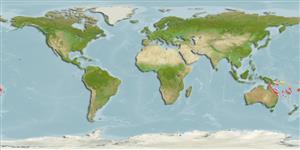>
Eupercaria/misc (Various families in series Eupercaria) >
Labridae (Wrasses) > Corinae
Etymology: Thalassoma: Greek, thalassa = the sea + Greek, soma = body; the colour of the sea (Ref. 45335); nigrofasciatum: Name from Latin, referring to the presence of black bars on the body..
More on author: Randall.
Environment: milieu / climate zone / depth range / distribution range
Ecologia
marinhas associadas(os) a recifes; intervalo de profundidade 0 - 15 m (Ref. 57555). Tropical; 7°S - 32°S, 142°E - 173°W
Western Pacific.
Tamanho / Peso / Idade
Maturity: Lm ? range ? - ? cm
Max length : 20.0 cm SL macho/indeterminado; (Ref. 57555)
Descrição suscinta
Morfologia | Morfometria
Espinhos dorsais (total): 8; Raios dorsais (total): 13; Espinhos anais 3; Raios anais : 11; Vértebras: 25. Diagnosis: Dorsal rays VIII,13. Anal rays III,11, the first spine, when detectable is very slender and short. Pectoral rays 15-16 (usually 15). Lateral line scales 26-27. Head naked, except for a small patch of scales dorsally on opercle. Gill rakers 20-23. Body depth 5.9-3.6 in SL; head length (HL) 3.1-3.4 in SL; snout length 8.4-9.8 in SL; caudal peduncle depth 6.2-6.65 in SL; pectoral fins 4.0-4.3 in SL; pelvic fins 6.3-6.9 in SL. The caudal fin is truncate in young individuals, becoming strongly lunate with filamentous lobes in adult males. The initial phase is white with postorbital head and anterior body above pectoral-fin base black with an oblique yellow band above dorsal edge of opercle, a black bar over last 4 or 5 dorsal spines continuing ventrally across body, its posterior edge vertical, and a broader black bar over last 9 soft rays of dorsal fin, across the body, and posterior anal fin; a black spot on first 2 membranes of dorsal fin; the terminal males with yellow partly replacing the white, a salmon pink patch on chin, and blue ventrally on head and chest (Ref. 57555).
Found solitary or in groups, most commonly on outer reef areas, and also found in coastal reefs, lagoons and tide pools (Ref. 57555, 90102).
Ciclo de vida ou comportamento de acasalamento
Maturidade | Reprodução | Desova | Ovos | Fecundidade | Larvas
Oviparous, distinct pairing during breeding (Ref. 205).
Randall, J.E., 2003. Thalassoma nigrofasciatum, a new species of labrid fish from the south-west Pacific. aqua, J. Ichthyol. Aquat. Biol. 7(1):1-8. (Ref. 57555)
Status na Lista Vermelha da UICN (Ref. 130435)
Ameaça para os humanos
Harmless
Uso pelos humanos
Mais informação
Idade/TamanhoCrescimentoPeso-comprimentoComprimento-comprimentoFrequências de comprimentoMorfometriaMorfologiaLarvasDinâmica larvalRecrutamentoAbundânciaBRUVS
ReferênciasAquaculturaPerfil para aquaculturaEstirpesGenéticaElectrophoresesHereditariedadeDoençasProcessamentoNutrientsConversão de massa
ColaboradoresFotosStamps, Coins Misc.SonsCiguateraVelocidadeTipo de nataçãoÁrea branquialOtólitosCérebrosVisão
Ferramentas
Relatórios especiais
Baixar XML
Fontes da internet
Estimates based on models
Preferred temperature (Ref.
123201): 24.6 - 28.5, mean 26.6 °C (based on 405 cells).
Índice de diversidade filogenética (Ref.
82804): PD
50 = 0.5000 [Uniqueness, from 0.5 = low to 2.0 = high].
Bayesian length-weight: a=0.00955 (0.00430 - 0.02123), b=3.06 (2.89 - 3.23), in cm total length, based on LWR estimates for this Genus-body shape (Ref.
93245).
Nível Trófico (Ref.
69278): 3.5 ±0.4 se; based on size and trophs of closest relatives
Resiliência (Ref.
120179): médio(a), tempo mínimo de duplicação da população 1,4 - 4,4 anos (Preliminary K or Fecundity.).
Fishing Vulnerability (Ref.
59153): Low vulnerability (14 of 100).
Nutrients (Ref.
124155): Calcium = 72.3 [42.9, 120.5] mg/100g; Iron = 0.646 [0.373, 1.205] mg/100g; Protein = 18.5 [15.6, 20.7] %; Omega3 = 0.138 [0.088, 0.214] g/100g; Selenium = 20.6 [12.2, 37.3] μg/100g; VitaminA = 145 [44, 526] μg/100g; Zinc = 1.63 [1.14, 2.59] mg/100g (wet weight);
